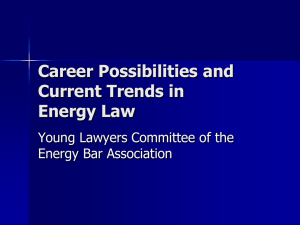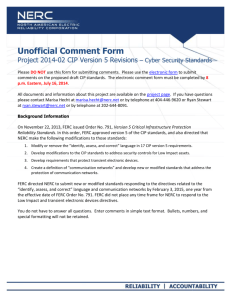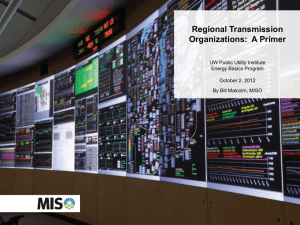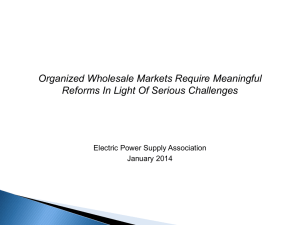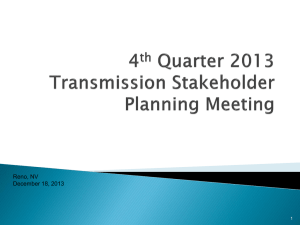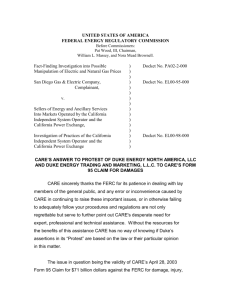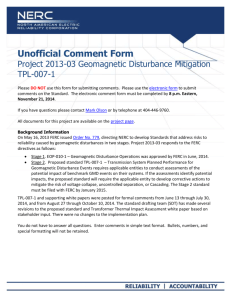GPSC SMD Comments on Pricing Policy filed 03/10/03
advertisement
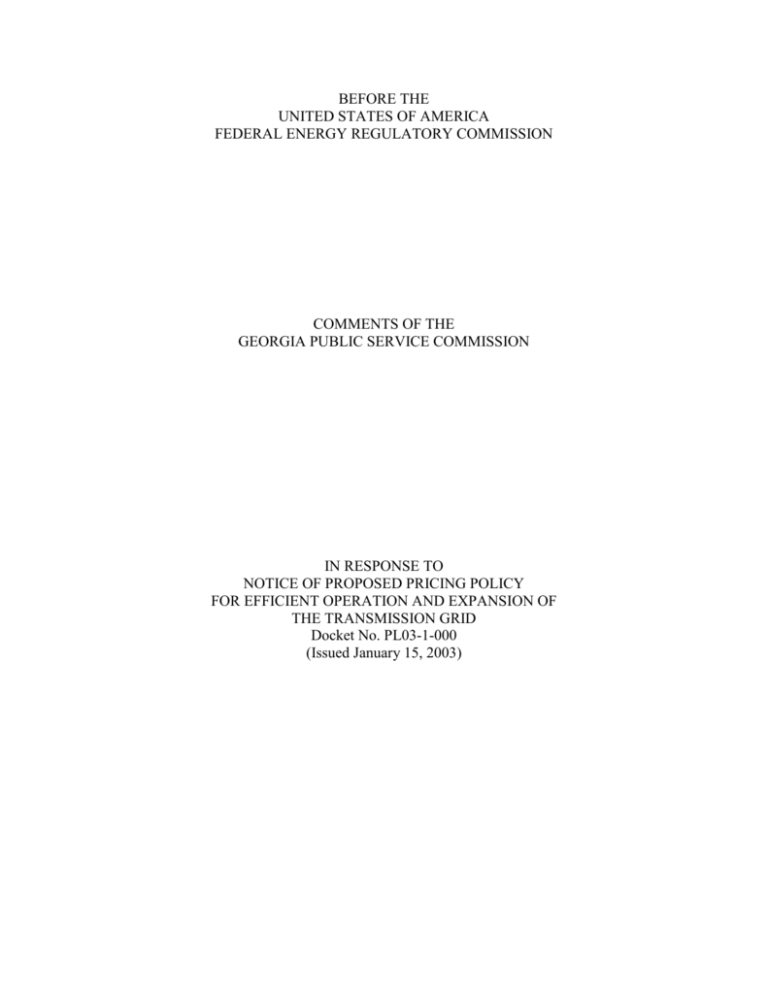
BEFORE THE UNITED STATES OF AMERICA FEDERAL ENERGY REGULATORY COMMISSION COMMENTS OF THE GEORGIA PUBLIC SERVICE COMMISSION IN RESPONSE TO NOTICE OF PROPOSED PRICING POLICY FOR EFFICIENT OPERATION AND EXPANSION OF THE TRANSMISSION GRID Docket No. PL03-1-000 (Issued January 15, 2003) The Georgia Public Service Commission (“GPSC” or “Commission”) appreciates the opportunity to submit comments on Docket No. PL03-1-000, Proposed Pricing Policy for Efficient Operation and Expansion of Transmission Grid (Issued January 15, 2003) as it affects Georgia’s retail customers. General Comments The GPSC views FERC’s proposed pricing policy as being largely dependent upon and tied to FERC’s proposals for Regional Transmission Organizations (“RTOs”) and Standard Market Design (“SMD”). The GPSC continues to have concerns regarding the increased costs associated with forming and operating the proposed SeTrans RTO and implementing the FERC’s proposed SMD for Georgia and the Southeast. Georgia is a state that currently enjoys relatively low-cost power that has been reliably supplied by vertically integrated utilities operating under traditional cost-based regulation. Our major concern, which bears repeating, is that implementation of an RTO and SMD will raise costs to consumers in our state and jeopardize the excellent reliability of our state’s utilities. FERC has not demonstrated that such drastic changes are needed at this time in Georgia. The major concern GPSC has with FERC’s proposed “incentives” policy which consists of an additional return on equity (“ROE”) is that this will raise transmission costs, which will in turn unnecessarily increase the cost of electricity to Georgia ratepayers. FERC should recognize that the GPSC is not opposed per se to providing utilities with incentives in the form of a higher ROE as a reward for efficient operations or for utilities that demonstrate their achievement of pre-established regulatory objectives. The GPSC recognizes that incentive mechanisms can be appropriate under appropriate circumstances and has established a number of incentive mechanisms for electric utilities that we regulate which include providing rewards for above-average nuclear plant operation1, for sharing of cost-savings between utility shareholders and ratepayers realized by purchase of power from a cogeneration plant2, and for sharing of excess returns under multi-year rate plans3, etc. Promoting Efficient Operation And Expansion Of The Transmission Grid One of FERC’s stated goals is to promote the efficient operation and expansion of the transmission grid. The GPSC agrees with FERC that this is an appropriate regulatory goal. The GPSC disagrees, however, with how this goal should be achieved. Establishing and operating an RTO in the Southeast is likely to add additional costs and is unlikely to produce net benefits. Consequently, rewarding RTO formation or inducing 1 The GPSC authorized Nuclear Performance Award applies to Georgia Power Company’s operation of the Hatch and Vogtle nuclear plants. 2 This incentive mechanism applies to Georgia Power Company’s purchases from a generating plant owned by Mid-Georgia Cogeneration. 3 The GPSC has implemented multi-year rate plans for Georgia Power Company which incorporate earnings sharing mechanisms. Page 2 of 5 transfers of existing transmission assets to an RTO by higher ROEs would not be appropriate. As explained in some detail in the GPSC comments submitted to FERC in RM01-12-000, an RTO and SMD are unnecessary and undesirable at this time for Georgia. FERC Has Not Demonstrated That Its Proposals Will Reduce Cost FERC is apparently assuming that its proposed policy, including its proposed rate incentives, would “reduce wholesale transmission and transactions cost.”4 However, FERC has not provided any reliable demonstration of cost savings for the Southeastern U.S. Indeed, the only reliable studies of which GPSC is aware show that increased costs and a general lack of net cost savings for the Southeast would result from implementing FERC’s proposals. The GPSC urges FERC to carefully consider the conclusions in the cost-benefit study conducted for SEARUC (“SEARUC Study”), which has been previously filed with FERC in Docket RM01-12-000.5 GPSC is aware of no other reliable studies of the likely cost impacts of FERC’s RTO and SMD proposals on the Southeast besides the SEARUC study. This study confirms the fears that the costs associated with FERC’s proposals are likely to outweigh the benefits for the Southeast region. As documented in the SEARUC Study (pp.95-96), the net benefit appears marginal or negative, and any net benefit can largely be attributed to implementing Participant Funding (p.96). Accordingly, GPSC has urged FERC to implement Participant Funding without delay, and without any requirement that new transmission projects be subject to planning and approval by an RTO.6 One of the SEARUC Study’s principal conclusions (p.1) is that: “There is considerable uncertainty as to whether RTOs and SMD would provide greater benefits to the southeast area than the implementation costs.” Prior to requiring any drastic changes to electricity and transmission markets in the Southeast, FERC should demonstrate that its proposals will produce a tangible net benefit, and will not cause harm to the native-load ratepayers. Because of the imminent danger of increased costs, and the lack of clear benefits or any real need for drastic changes to a regional electric system that is functioning very well in the Southeast, the GPSC believes that FERC should respect regional differences and adopt a more deliberative and cautious approach. FERC should not mandate drastic changes that are unlikely to produce a net economic benefit, and risk significantly increasing costs and potentially jeopardizing reliability to the retail ratepayers of the Southeast region. As far as the GPSC can determine, the incentives proposed by FERC in PL03-1-000 would only increase the cost of transmission and thus would make the cost-benefit equation even worse from the retail end-user’s perspective. As noted above, the SEARUC study demonstrated a lack of clear cost-saving benefits in excess of the increased costs associated with FERC’s RTO/SMD proposals Other things being equal, 4 See, e.g., PL03-1-000 Summary. 5 See Appendix C to the November 15, 2002, comments filed by the Louisiana Public Service Commission, “The Benefits and Costs of Regional Transmission Organizations and Standard Market Design in the Southeast” prepared for the Southeastern Association of Regulatory Utility Commissioners by Charles River Associates, dated November 6, 2002. 6 See GPSC comments in RM01-12-000 Page 3 of 5 adding FERC’s proposed ROE incentives to the existing cost of transmission would increase transmission rates, and the costs of FERC’s RTO/SMD proposals would be even higher than those modeled in the SEARUC study. The FERC-Proposed Incentives Appear To Undercut The Requirements Of Order No. 2000 For A Cost-Benefit Analysis And Identification Of Resultant Benefits Order No. 2000 requires that all innovative pricing proposals should be fully justified.7 Justification requirements include that the applicant “provide a cost-benefit analysis, including rate impacts; and explain why the proposed rate treatment is appropriate ….” 8 Additionally, the applicant “must identify how the rate treatment promotes efficiency and what benefits result.”9 The FERC proposed incentives appear to undercut these requirements. Instead of having to provide a cost-benefit analysis for justification, under FERC’s incentive proposal, an entity would earn an incentive adder of 50 basis points to its ROE merely for transferring facilities to a approved RTO. The GPSC sees no demonstrated benefit to this. However, transfer of a utility-owned transmission plant to an RTO would create the potential for increased costs (which would now include a higher ROE because of the proposed incentive). Instead of these FERC-proposed ROE incentives, which would increase transmission rates and which appear to have no costbenefit support, a better policy would be to restrict such incentives to only those situations where a reliable cost-benefit analysis, including rate impacts, demonstrates that net benefits will result. The GPSC urges FERC to adjust its proposed policy to require the transmission owner to present a reliable cost-benefit analysis, including rate impacts, that demonstrates that benefits will result, before any ROE enhancement incentives can be authorized. Enhanced ROE Incentives Should Not Apply to Existing Facilities FERC’s proposed policy would provide incentive ROE adders for existing transmission facilities under two circumstances. First, under the proposal, any entity that transfers operational control of transmission facilities to a FERC-approved RTO would qualify for an incentive adder of 50 basis points of ROE for all such facilities transferred. Secondly, under FERC’s proposal, independent transmission companies (ITCs) that participate in RTOs and meet FERC’s independent ownership requirement would qualify for an additional incentive of 150 basis points of ROE applied to the book value of the facilities at the time of the divestiture. Thus, under FERC’s proposals, existing transmission plant could qualify for as much as 200 basis points of additional ROE, and result in higher transmission rates to “cover” the additional cost of such incentives. The GPSC believes that this policy proposal by FERC is inappropriate and should not be implemented because it would increase wholesale transmission rates and has not been demonstrated to produce any net cost savings. Please also refer to the GPSC’s concerns regarding the extra costs associated with the formation and operation of RTOs that have been expressed in more detail in comments 7 See e.g., §35.34(e) of FERC’s regulations, 13 CFR 35.34(e) (2002) (innovative rate treatments for RTOs). 8 Id. 9 Id. Page 4 of 5 submitted in Docket No. RM01-12-000 and to the results of the SEARUC study cited above. Enhanced ROE Incentive For Investment In New Transmission FERC’s third proposed generic ROE-based incentive is for 100 basis points for investment in new transmission facilities that are found to be appropriate pursuant to an RTO planning process. The GPSC believes an incentive for new transmission facilities may be appropriate under certain circumstances; however, such incentive should be tied to a reliable cost-benefit analysis, including rate impacts, that demonstrates that benefits will result, before any ROE enhancement incentives are authorized. As noted above, and in comments submitted in Docket RM01-12-000, GPSC is not in favor of FERC’s RTO proposals. The GPSC believes that eligibility for an incentive ROE for cost-beneficial investment in new or expanded transmission facilities should not be contingent on such construction being part of an RTO planning process. If new transmission investment is cost-beneficial and can be demonstrated to produce cost savings, e.g., by reducing wholesale rates or relieving known congestion, under such circumstances an ROE-based incentive may be appropriate because it could encourage the prompt construction of such needed transmission. As one illustrative example, the SEARUC study (at page 30) concludes that “expansion of the Florida-Southern interface would have more benefits than costs.” Moreover, “it would appear to be possible to expand this interface regardless of FERC’s RTO/SMD policy, given that it is economical to do so either in the base case or in the RTO/SMD cases.” Whether such a potentially beneficial transmission project is constructed pursuant to an RTO planning process, or is constructed independently of an RTO planning process, should not be determinative of whether an investment in new transmission facilities would be eligible for an ROE-based incentive. Finally, the GPSC is concerned that if utilities wait until beneficial upgrades can be included in an RTO planning process (e.g., in an attempt to “qualify” such projects for a FERC-proposed ROE incentive), FERC’s proposed policy may unduly delay the investment in such needed transmission facilities. The GPSC appreciates the opportunity given by the FERC to provide its comments and thoughts on these important matters. The GPSC remains open to discussion on the positions taken in this document. Page 5 of 5
